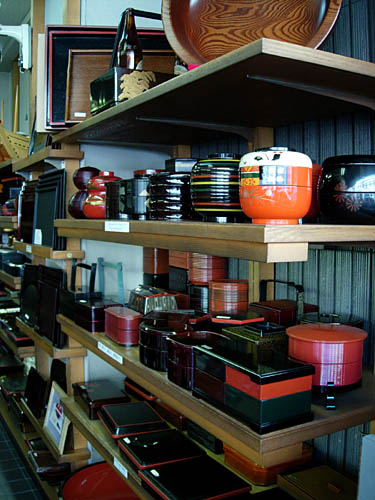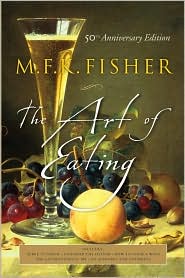 I went to the stacks the other day to find a book for a patron that needed to be somewhat new and exciting and have a lot of ethnic vegetarian recipes in it. It was great to find her something that she liked, and afterwards I decided to go back and pull a few more books off the shelf that I hadn't seen for awhile or ones that had hidden themselves away from me. The three I pulled all sit together rather nicely, as they are beautifully designed and handsome as a set. And while they represent three different types and styles of cooking, one could mix and match recipes from them and come up with some very exciting menus.
I went to the stacks the other day to find a book for a patron that needed to be somewhat new and exciting and have a lot of ethnic vegetarian recipes in it. It was great to find her something that she liked, and afterwards I decided to go back and pull a few more books off the shelf that I hadn't seen for awhile or ones that had hidden themselves away from me. The three I pulled all sit together rather nicely, as they are beautifully designed and handsome as a set. And while they represent three different types and styles of cooking, one could mix and match recipes from them and come up with some very exciting menus.Olive Trees and Honey: A Treasury of Vegetarian Recipes from Jewish Communities Around the World/Gil Marks/Wiley Publishing, 2005. There aren't as many Jewish cookbooks on the shelves as I would like to see. Many are less than ethnic and more American in style and taste, an assimilation of styles of home cooking that leave the diner or the cook less than satisfied and wondering if all the recipes that they are finding are typical or stereotypical in nature. Olive Trees and Honey takes us on a world wide tour of Jewish cooking and makes it unique in two ways: one, these recipes are all vegetarian, and two, they are approached from a larger, global, decidedly ethnic point of view.
The recipes focus not only on festival and Sabbath foods found in all Jewish communities, but also on foods shaped by the various regions and groups Jews have melded with. The recipes that we think of today as Jewish food have been altered and synthesized from these unique recipes and far flung regions, and yet, as you go through this fascinating overview, you find yourself wondering why so much of it has been "lost" up till now. Lost to us here in the United States, mostly, but still. Indulge in this title and you will find foods that are Sephardic, Mediterrean, Israeli and Ashkenazim as well.
Within these pages you'll find exquisite recipes like Romanian Stuffed Mushrooms, Middle Eastern Stuffed Zucchini in Yogurt Sauce, Moroccan Spicy Chickpeas, Azerbaijani Rice Pilaf, Czech Bread Dumplings, Italian Eggplant Relish, Central European Cabbage Strudel, Yeminite Baked Flaky Rolls and Shephardic Leek and Cheese Casserole. These foods come from 'round the world and will be a welcome break from traditional deli foods that we associate with urban Jewish cooking. Look up this title soon and be amazed at what "real" Jewish cooking is all about.
Seductions of Rice: a Cookbook/Jeffery Alford and Naomi Duguid/Artisan, 1998. This duo continues to amaze me with their wonderful titles. Each one is a treasure, filled with fantastic photographs, incredible recipes and seductive travelogue. This particular title is one of their first, with a primer chapter up front covering all the basics one needs to know about all the various types and forms of rice found 'round the world, and then a world wide overview of rice as it's used and prepared in various lands. As you might expect there is an extensive section on rice as it's used in Asia, but recipes out of Africa, North America and the Mediterranean are eye opening and tasty as well.
I've enjoyed this book so much that I've personally owned and given away three copies of this book to friends and family. And it's easy to, with dishes such as Stir-fried Shrimp Kerala Style, Lamb and Peanut Stew, Hoppin' John with a Side of Peas, Aromatic Rice Pudding, Gobindavog Rice from Calcutta, Thai Red Curry Paste and Three Quick Dashi Broths, a quintessential broth out of Japan. Be sure to check out their other titles as well, as each one builds on the one before it. They just keep getting better and better.
Fonda San Miguel: Thirty Years of Food and Art/Tom Gilliland and Miguel Ravago, Text by Virginia B. Wood, Foreword by Diana Kennedy/Shearer Publishing, 2005. I like the way that cookbooks are heading these days. Yes, I understand that there are reasons to have cookbooks on the shelves packed solid with print and recipes, ones just like The Joy of Cooking, and then there are good reasons for large, oversized, thick-n-glossy publications to be on the shelves that not only glorify and "paint" food in a beautiful light, but also bring you into a world where food and culture and art all come together and make a glorious synergistic experience out of food, enticing you and encouraging you to get up off the couch and make your way into the kitchen.
This particular title sings praises about art and at the same time tells the tale of dedicated folks working together to bring to you unique and long lost foods in beautiful surroundings. Many of the recipes are twists on old Mexican traditionals, but for many these recipes will be unique and satifying as they are more regional than what folks expect in a Tex-Mex border recipe saturated world. Take, for instance, a Fonda San Miguel signature dish, Pollo en Mole de Zarzamoras, Chicken in Blackberry Mole. That dish could easily become your own signature dish here in the Pacific Northwest in the summer time. I certainly plan on making it mine!
Cooks talk!

















No comments:
Post a Comment